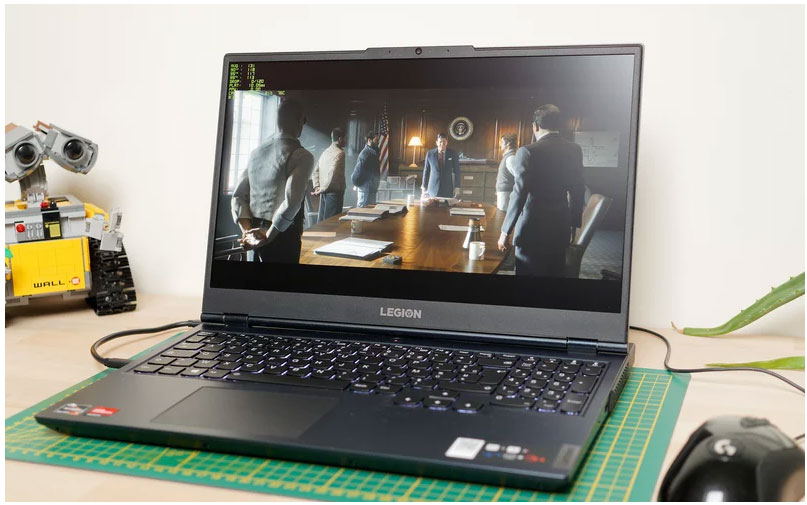Lenovo Legion 5
Lenovo offers a new version of the Legion 5, its most affordable chassis for gamers. In this 15ACH6A version, it embeds an AMD RX 6600M graphics card, a 165 Hz panel and an 80 Wh battery.
Presentation
After its Legion 5 equipped with a GeForce RTX 3060 signed Nvidia of the most convincing, Lenovo offers a variation with a graphics card AMD RX 6600M. At the same time, the gaming laptop becomes eligible for the AMD Advantage program.
Construction
The Lenovo Legion 5's shell is clad in a midnight blue plastic, which is found around the keyboard. The edges of the panel are made of grainy black plastic, as is the bottom shell. The hinge is slightly advanced on the chassis or, depending on the point of view, the chassis overflows 3 cm behind the screen.
Once opened, the computer reveals a keyboard with a numeric keypad. The positioning of the keys is relatively dense, but Lenovo has taken care to shift the arrow keys downwards. The keyboard is backlit on two levels and the Fn-Space shortcut switches between each mode. The typing experience is pleasant and the keyboard does not suffer from any noticeable defects. The touchpad, barely wider than the space bar, offers a decent glide and a good return of the right and left clicks. The center click is relatively hard and does not allow you to drag and drop while holding the pressure.
The Legion 5's connectivity is particularly rich with, on the left, a USB Type-C port and the headphone/mic combo jack. On the right, there is a USB 3.0 port, a switch for the webcam and a power indicator. The latter doubles as the power button above the keyboard with an LED. Finally, between the two vents on the rear of the chassis, there are also three USB 3.0 ports, the charging socket in the proprietary format, an HDMI 2.1 port, an RJ45 port, as well as a USB Type-C port compatible with Power Delivery and DisplayPort.
Wireless connectivity is provided by the Intel AX201 chip offering wifi 6 (2,400 Mb/s) and Bluetooth 5.2. The 720p webcam above the screen is once again of poor quality, with a blurred effect in the details.
Cooling is provided by two fans that blow on four radiators located in the corners under the hinge of the screen. Lenovo allows a change of energy profile without going through a software thanks to the keyboard shortcut FN-Q. The LED on the start button changes color depending on the selected mode: blue for silent, white for automatic and red for turbo mode.
In turbo mode, we found a maximum temperature of 42.3°C between the arrow keys. The Z, Q, S and D keys remain relatively cool with 37.6 °C measured. Thus, the right side of the keyboard is the hottest part of the chassis, just above the Radeon RX 6600M and its 100W TDP. The vents of the RTX 3060 are much hotter (55.7 °C and 49.6 °C) than those dedicated to the Ryzen 7 5800H (50.5 °C and 46.6 °C).
Noise pollution is contained in silent mode, with 38.1 dB recorded in game. In automatic mode, the Legion 5 is heard more with 44.6 dB. However, this is still in the average range of gaming laptops. In turbo mode, on the other hand, the computer is disturbing with 49.3 dB measured, causing the editors of Les Numériques to make comments from their office neighbors.
With the game Assassin's Creed Valhalla, we also observed a notable difference in performance depending on the profile: 57 fps in silent mode, 72 fps in auto mode and 78 fps in turbo mode.
Access to the components is done by removing ten Phillips screws. However, the shell is difficult to remove. We advise you to start from the front with an old bank card or a special tool. The most difficult part is the firmly clipped air vents. You just have to lift the shell to free all the rear connections.
When opened, there is a free M.2 slot on the left, under an aluminum plate held by three screws. Under the square aluminum plate are two DDR4 slots. Under the aluminum plate on the right is the SSD in M.2 format and the wifi card. The battery is not glued and is released after the removal of four screws. On our model, Lenovo has selected a battery of 80 Wh occupying the entire width of the chassis.

Performance
Our Lenovo Legion 5 packs an AMD Ryzen 7 5800H processor with 8 multithreaded cores, accompanied by 16GB of RAM and a 512GB SSD. In practice, the processor reaches a maximum of 4.4 GHz during our encoding under HandBrake, with an average of 3.9 GHz.
The Ryzen 7 5800H delivers high performance. On our hands-on test panel, it gets a performance index of 126, in line with what we expected. It performs slightly better than an Intel Core i7-11800H (123), and logically lags behind the Ryzen 9 5900HX and the Intel Core i9-11980HK.
For its part, the NVMe-type SSD reaches 3.6 GB/s read and 2.3 GB/s write. We didn't notice any cache saturation, even when moving our rushes to test Adobe's Premiere editing software.
Games
The graphics part is therefore provided by the Radeon RX 6600M from AMD. The TGP can reach 100W thanks to the SmartShift function, which allows to switch the unused power from the processor to the GPU and vice versa depending on the situation. Since the Lenovo Legion 5 does not have a MUX chip, it is necessary to disable the hybrid mode in Lenovo Vantage in order to get the best performance from the graphics card.
The Radeon RX 6600M gets a rating of 131, handicapped by its raytracing performance. For comparison, it is consistently behind the GeForce RTX 3060 and far behind the Radeon RX 6800M (147).
In games, the Lenovo Legion 5 and its RX 6600M achieve convincing results with more than 60 fps, with all graphical details pushed to the maximum; except in Cyberpunk, where the Psycho settings put a strain on framerate. In raytracing, the RX 6600M only does well in Godfall, the rest of our panel being unplayable with this rendering.
In competitive and less demanding games, the Radeon RX 6600M should easily reach the limits of its 165Hz slab, or 165 fps.

Screen
As mentioned above, Lenovo has swapped the 120Hz Full HD IPS panel for a Full HD model with a 165Hz refresh rate. A point to check when buying, especially since this new screen is much better.
The passage under our probe confirms that Lenovo was well inspired to equip its Legion 5 with this screen signed BOE. The colorimetry is perfect with a delta E lower than 3 (2,3), the differences of color being imperceptible for the human eye. Just like the reactivity with 10 ms of latency measured. The contrast is rather low with a value of 1112:1, far from the best IPS panels that culminate lately around 1400:1. In use, the blacks will be gray. The color temperature is 6253K, slightly below the video standard of 6500K. The brightness is just over 300 cd/m², an acceptable value for a PC intended for sedentary use. However, thanks to the matte panel, reflectance is relatively low (17.6%). You will not have to orientate your screen according to the lighting or the surrounding windows.
Audio
The two speakers are located under the chassis, so the rendering will depend on the support on which the Legion 5 is placed. When listening, the sound volume lacks power. The fan in turbo mode can cover the sound of the speakers. The rendering suffers from a lack of bass and is somewhat nasal. The presence of the Nahimic software does not help, so we might as well disable it in its options.
The headphone jack does not necessarily raise the level. The output power is correct, but remains a little weak to connect headphones with high impedance. The other measured values are in the average of what we usually find, without any of them standing out.
Autonomy
The Lenovo Legion 5 is similar in size to its competitors, with 36.2 cm wide by 26 cm deep and 2.5 cm thick. The whole thing weighs 2.42 kg and is therefore relatively easy to carry once slipped into a suitable backpack. It is rather on the side of the charger of 300 W that our attention is focused: this one shows not less than 1 088 g on the scale and thus comes strongly to weigh down the computer. Lenovo has seen big while the configuration does not consume more than 240 W at the plug.
Although equipped with an 80 Wh battery, our Lenovo Legion 5 in hybrid mode does not exceed 6 h 30 min of autonomy in video playback with a brightness of 200 cd/m². When we tested the GeForce RTX 3060 version, the PC had a 60 Wh battery and lasted a little over 7 hours. Note that switching to silent mode does not improve the final autonomy.
Conclusion
Lenovo corrects the main flaw of its Legion 5 by equipping it with a new 165 Hz panel that is more responsive and, above all, more colorful. As for performance, the Ryzen 7 5800H processor works wonders; the AMD Radeon RX 6600M graphics card offers an interesting performance, but lacks versatility compared to the competition.




